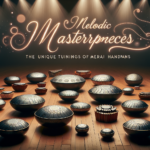In the realm of modern music, the handpan has emerged as a revolutionary instrument, straddling the lines between percussion and melody. This unique instrument, characterized by its distinctive UFO-like appearance and mesmerizing sounds, is captivating musicians and listeners alike. From casual street performances to professional studio recordings, handpan tracks are breaking musical boundaries, creating a fusion that echoes across genres and cultures.
The Origins of the Handpan
The handpan traces its roots back to the year 2000 when it was first developed in Switzerland by Felix Rohner and Sabina Schärer of PANArt. It was derived from the steelpan but stood out due to its capacity to produce both harmonious melodies and entrancing rhythms using its concave, drum-like shape. While the steelpan traditionally originated from Trinidad and Tobago, the handpan’s evolution brought an innovative twist that combined acoustic curiosity with soulful resonance.
Musical Fusion and Cultural Integration
The handpan has a unique ability to blend seamlessly into various musical styles, from classical and jazz to electronic and world music. Its versatility lies in its capacity to produce both ambient soundscapes and intricate rhythmic patterns.
In world music, for instance, handpan performances often integrate elements from various cultural traditions, creating a globally infused audio tapestry. By merging sounds from Indian ragas, African drumming, and European classical traditions, handpan musicians craft compositions that transcend cultural boundaries, promoting a universal language of music.
Impact on Modern Music Genres
The influence of the handpan on contemporary music cannot be overstated. In genres like ambient, new age, and electronica, the handpan’s ethereal tones provide a meditative quality that enhances the listening experience. Artists and producers are increasingly weaving handpan sounds into their tracks to evoke emotions ranging from tranquility to excitement.
Moreover, in live performances, the handpan often serves as a centerpiece, captivating audiences with its hypnotic tones. Its presence in festivals, concerts, and even yoga retreats underscores its rising popularity and broad appeal.
The Aesthetic Appeal
Beyond its sonic capabilities, the handpan captivates aesthetically. Crafted by meticulous artisans, each handpan is a piece of art, featuring unique designs and tunings. The visual allure of the instrument enhances its mystique, captivating audiences even before a single note is played.
Handpan makers often experiment with varying materials and craftsmanship techniques to produce instruments that not only sound exceptional but also look visually stunning. This emphasis on artistry extends to the performers, who often employ expressive gestures and movements, creating a holistic sensory experience.
Technological Innovations
The digital age has also played a significant role in propelling the handpan into the spotlight. With advances in recording technology and digital audio workstations (DAWs), musicians can now capture the nuanced sounds of the handpan with unprecedented clarity and detail.
Furthermore, virtual handpans and sample libraries have emerged, making the instrument accessible to a broader audience. These digital tools allow producers to incorporate handpan sounds into their compositions without needing to own a physical instrument. This democratization of access has spurred creativity and experimentation, further pushing the boundaries of what handpan music can be.
Collaborative Efforts and Influences
The handpan community is inherently collaborative, with artists frequently working together to push the instrument to new heights. Collaborations between handpan players and musicians from other disciplines have resulted in groundbreaking projects that blur genre lines.
For example, collaborations between handpan players and electronic music producers have led to the creation of tracks that blend organic and synthetic sounds, creating a rich audio landscape. Jazz musicians incorporate handpan sounds into their improvisations, adding a new dimension to their performances. These collaborative efforts underscore the handpan’s versatility and its potential to influence and reshape musical conventions.
The Future of Handpan Music
As the handpan continues to gain recognition and popularity, its impact on the music industry is likely to grow. Musicians and producers will undoubtedly continue to explore new ways to integrate the handpan into their work, pushing the instrument’s boundaries and expanding its sonic repertoire.
Educational institutions and music programs are also beginning to recognize the handpan’s potential, incorporating it into their curricula and fostering a new generation of handpan players. This institutional support will further cement the handpan’s place in the musical pantheon and ensure its continued evolution and innovation.
Conclusion
The handpan is a testament to the power of musical innovation and the boundless possibilities that arise when tradition meets modernity. Its unique sound, visual elegance, and cultural versatility have made it a beloved instrument in various musical circles. As handpan tracks continue to break musical boundaries, they forge new paths for artistic expression and cross-cultural dialogue. Whether through live performances, studio recordings, or digital compositions, the handpan is set to leave an indelible mark on the world of music, shaping its future in ways we can only begin to imagine.
Frequently Asked Questions
- Q1: What is a handpan?
- A handpan is a musical instrument created in the early 2000s, resembling a UFO in shape. It is played by striking its surface with hands and fingers, producing harmonic melodies combined with percussive rhythms.
- Q2: How is a handpan different from a steelpan?
- While both instruments share similarities, a handpan is distinct in its ability to produce melodic and rhythmic sounds simultaneously. The steelpan, originating from Trinidad and Tobago, is played with mallets and focuses on melodic percussions.
- Q3: In which musical genres is the handpan used?
- The handpan is versatile and is used in various genres including ambient, new age, world music, electronica, jazz, and classical music. Its unique soundscapes also make it popular in yoga and meditation settings.
- Q4: Do I need special training to play the handpan?
- While basic rhythms can be picked up relatively quickly, mastering the handpan’s full potential requires practice and possibly lessons. Many players start with online tutorials before progressing to more advanced techniques.
- Q5: Can I use a digital handpan in my music projects?
- Yes, there are virtual handpans and sample libraries available. These digital tools allow musicians and producers to incorporate handpan sounds into their compositions without owning a physical instrument.





